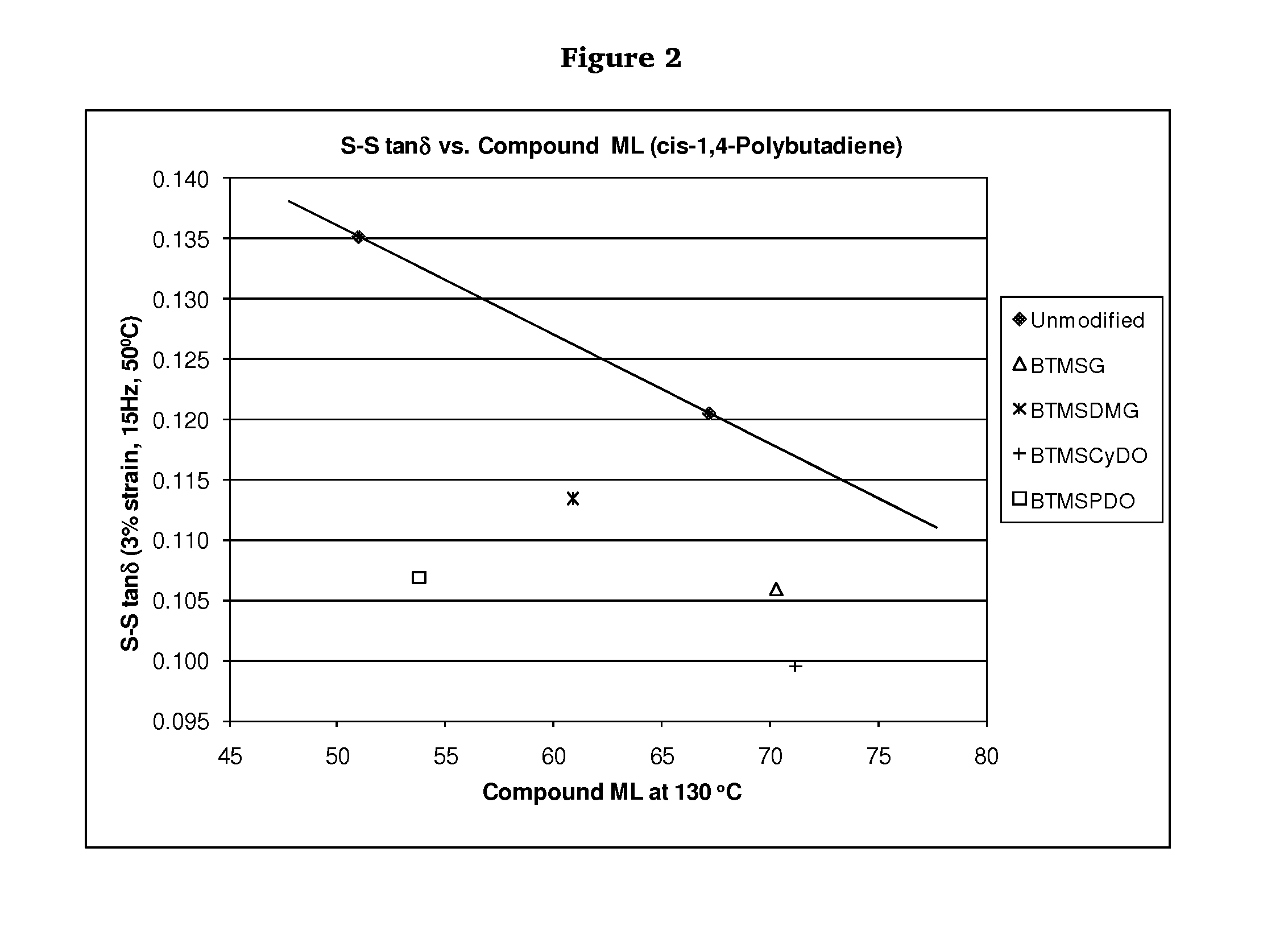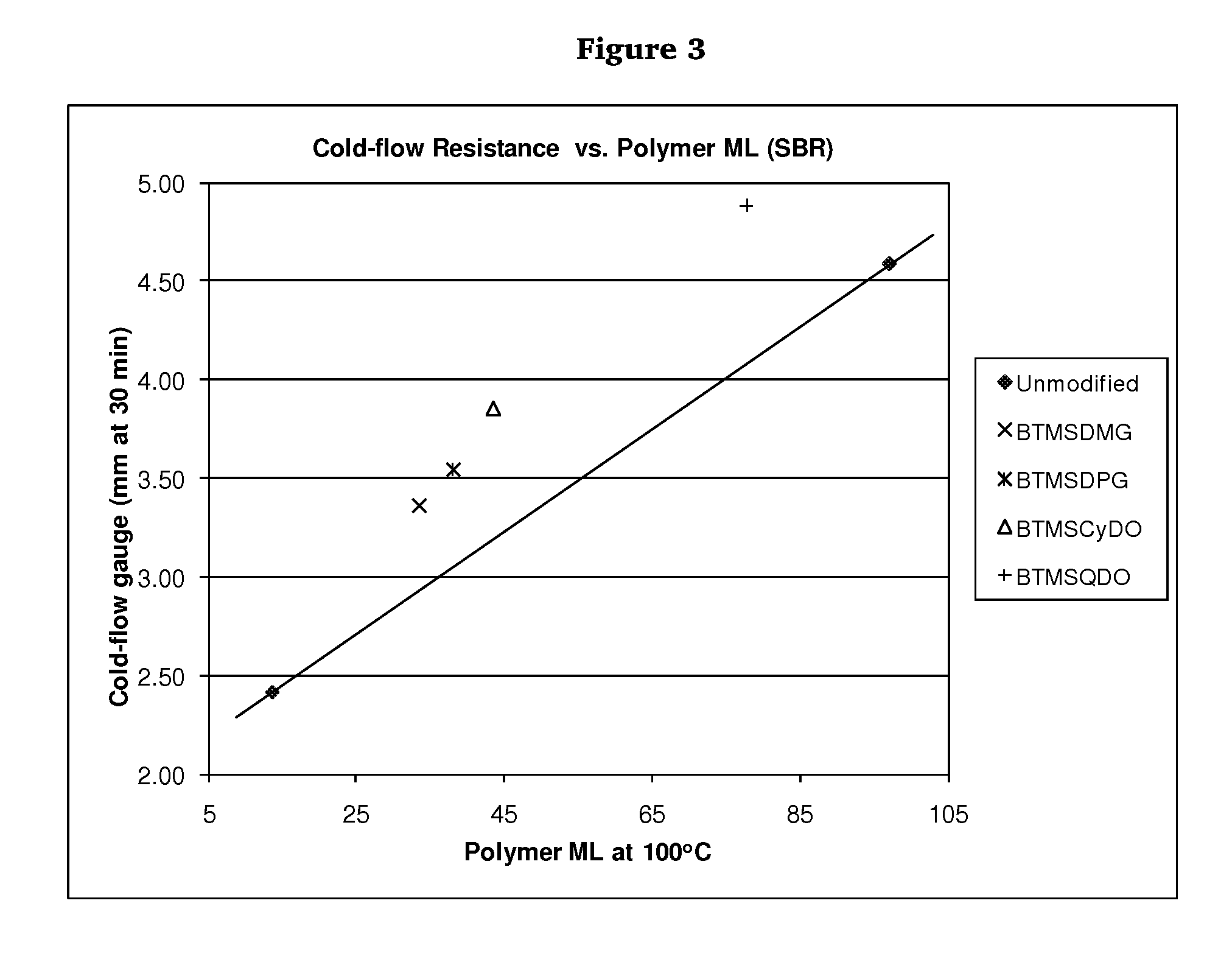Polymers functionalized with polyoxime compounds and methods for their manufacture
- Summary
- Abstract
- Description
- Claims
- Application Information
AI Technical Summary
Benefits of technology
Problems solved by technology
Method used
Image
Examples
example 1
Synthesis of Unmodified cis-1,4-Polybutadiene
[0164]To a 2-gallon nitrogen-purged reactor equipped with turbine agitator blades were added 1383 g of hexane and 3083 g of 20.6 wt % 1,3-butadiene in hexane. A preformed catalyst was prepared by mixing 7.35 ml of 4.32 M methylaluminoxane in toluene, 1.83 g of 20.6 wt % 1,3-butadiene in hexane, 0.59 ml of 0.537 M neodymium versatate in cyclohexane, 6.67 ml of 1.0 M diisobutylaluminum hydride in hexane, and 1.27 ml of 1.0 M diethylaluminum chloride in hexane. The catalyst was aged for 15 minutes and charged into the reactor. The reactor jacket temperature was then set to 65° C. About 60 minutes after addition of the catalyst, the polymerization mixture was cooled to room temperature and quenched with 30 ml of 12 wt % 2,6-di-tert-butyl-4-methylphenol solution in isopropanol. The resulting polymer cement was coagulated with 12 liters of isopropanol containing 5 g of 2,6-di-tert-butyl-4-methylphenol and then drum-dried. The Mooney viscosity (...
example 2
Synthesis of Unmodified cis-1,4-Polybutadiene
[0167]To a 2-gallon nitrogen-purged reactor equipped with turbine agitator blades were added 1631 g of hexane and 2835 g of 22.4 wt % 1,3-butadiene in hexane. A preformed catalyst was prepared by mixing 6.10 ml of 4.32 M methylaluminoxane in toluene, 1.27 g of 22.4 wt % 1,3-butadiene in hexane, 0.49 ml of 0.537 M neodymium versatate in cyclohexane, 5.53 ml of 1.0 M diisobutylaluminum hydride in hexane, and 1.05 ml of 1.0 M diethylaluminum chloride in hexane. The catalyst was aged for 15 minutes and charged into the reactor. The reactor jacket temperature was then set to 65° C. About 72 minutes after addition of the catalyst, the polymerization mixture was cooled to room temperature and quenched with 30 ml of 12 wt % 2,6-di-tert-butyl-4-methylphenol solution in isopropanol. The resulting polymer cement was coagulated with 12 liters of isopropanol containing 5 g of 2,6-di-tert-butyl-4-methylphenol and then drum-dried. The properties of the ...
example 3
Synthesis of cis-1,4-Polybutadiene Modified with Glyoxal Bis(O-trimethylsilyloxime) (BTMSG)
[0168]To a 2-gallon nitrogen-purged reactor equipped with turbine agitator blades were added 1553 g of hexane and 2913 g of 21.8 wt % 1,3-butadiene in hexane. A preformed catalyst was prepared by mixing 8.08 ml of 4.32 M methylaluminoxane in toluene, 1.73 g of 21.8 wt % 1,3-butadiene in hexane, 0.65 ml of 0.537 M neodymium versatate in cyclohexane, 7.33 ml of 1.0 M diisobutylaluminum hydride in hexane, and 1.40 ml of 1.0 M diethylaluminum chloride in hexane. The catalyst was aged for 15 minutes and charged into the reactor. The reactor jacket temperature was then set to 65° C. About 55 minutes after addition of the catalyst, the polymerization mixture was cooled to room temperature.
[0169]About 428 g of the resulting unmodified polymer cement (i.e., pseudo-living polymer cement) was transferred from the reactor to a nitrogen-purged bottle, followed by addition of 5.26 ml of 0.500 M glyoxal bis(...
PUM
| Property | Measurement | Unit |
|---|---|---|
| Percent by mass | aaaaa | aaaaa |
| Temperature | aaaaa | aaaaa |
| Temperature | aaaaa | aaaaa |
Abstract
Description
Claims
Application Information
 Login to View More
Login to View More - R&D
- Intellectual Property
- Life Sciences
- Materials
- Tech Scout
- Unparalleled Data Quality
- Higher Quality Content
- 60% Fewer Hallucinations
Browse by: Latest US Patents, China's latest patents, Technical Efficacy Thesaurus, Application Domain, Technology Topic, Popular Technical Reports.
© 2025 PatSnap. All rights reserved.Legal|Privacy policy|Modern Slavery Act Transparency Statement|Sitemap|About US| Contact US: help@patsnap.com



